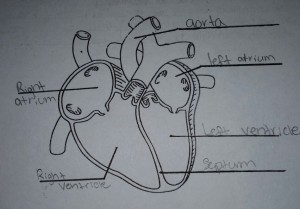CARDIOVASCULAR HEALTH
LESSON #3 Hand In
THE CARDIOVASCULAR SYSTEM:
The heart, lungs and blood vessels all work together as a unit!
1. _?_ refers to the heart. Vascular refers to the system of blood vessels.
2. These vessels can be either veins (bring de-oxygenated blood back to the heart) or artery’s (bring oxygenated blood from the heart to the muscles and organs).
3. Deoxygenated blood enters the heart in the right atrium. Next it is pumped into the right ventricle. Blood then travels to the lungs to pick up oxygen before it returns to the left heart to be pumped out to the body.
4. Where is your heart and how big is it? Size of the clenched fist and is in the left side of your chest
LABEL THE HEART:
Left Atrium: holds oxygenated blood from the lungs.
Left Ventricle: pumps oxygenated blood throughout the body.
Right Atrium: holds deoxygenated blood that has returned from the body.
Right Ventricle: pumps deoxygenated blood to the lungs.
Aorta: the largest artery in the body – transports oxygenated blood from the heart to the body.
Septum: the thick wall that divides the heart into two separate sides.
HEART DISEASE:
5. What heart related illness is the leading cause of death in North America?
Cardiovascular disease
6. Name 4 factors that contribute to cardiovascular disease:
High blood pressure
High cholesterol
Smoking
Family history
7. List three strategies for preventing heart disease?
Diet
Exercise
Stress control
CARDIOVASCULAR ENDURANCE:
1. How do you exercise the heart?
By being active and exercising
2. Describe each of the following terms:
a. Resting Heart Rate: Number of beats per minute when resting (lying down, Sitting)
b. Maximum Heart Rate: Age related number of beats per minute of heart when working at its max
c. Target/Training Heart Rate: 55-85 percent of your max heart rate for 20-30 minutes
d. Recovery Heart Rate: When your heart settles down after exercising or working your heart

Leave a Reply